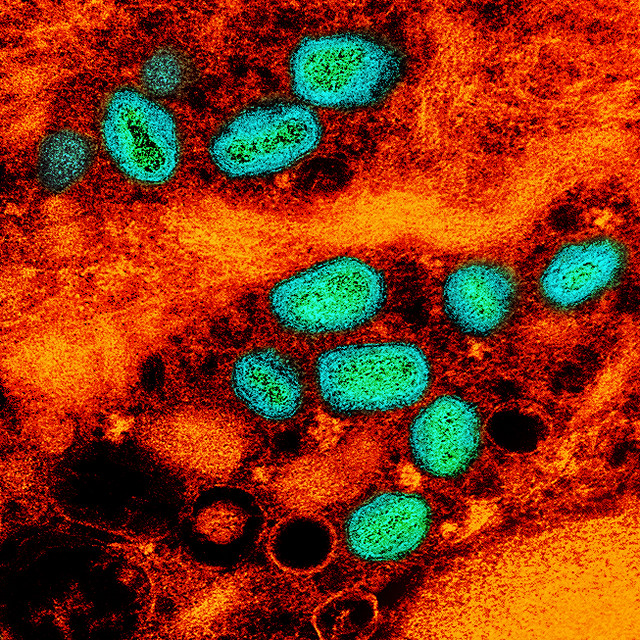Image courtesy of NIAID; CC-BY 2.0 DEED
Mpox, previously known as monkeypox, was discovered in 1958 and is caused by the monkeypox virus. Mpox spreads between animals and humans (i.e., a zoonotic disease) or human to human, and has been found in mammals, small rodents, and monkeys living in central and West Africa.1 Symptoms of mpox are similar to those of smallpox (e.g., lesions, fever, malaise), but are typically less severe.1,2 There are two different types of mpox that have been discovered, Clade I and Clade II. Clade I is the most common type in the Democratic Republic of Congo (DRC) and leads to death in 1 out of every 10 people infected.1,2 Clade II is milder, with 99.9% of those that are infected surviving. Clade II is typically found in West Africa and was the strain responsible for the mpox global outbreak in 2022, which resulted in fewer than 200 deaths globally.2, 3
Mpox is endemic, and therefore constantly circulating in central and west African countries, but spread to areas in Europe and North America in May 2022.1,3 The global outbreak brought increased awareness to the burden of mpox in Africa, but it is important that these conversations and support are maintained to address the ongoing morbidity and mortality of the virus.4 There is a vaccine against mpox for people who may have been exposed or are at risk; however, this vaccine is not currently authorized in Africa, due to a lack of data on vaccine effectiveness in malnourished populations, especially children.2, 4 Additionally, there is a PCR test for confirming mpox infections, which is only available in two laboratories in the DRC, making it difficult to distinguish a mpox case from other similar diseases.2, 6 Other prevention measures include washing hands often, avoiding touching objects that someone who is infected has used, and avoiding close contact with people or animals with a rash similar to the one seen in mpox patients.7
The DRC is currently facing a mpox outbreak involving the Clade I strain in 23 out of their 26 provinces, with over 3,500 suspected cases and over 250 deaths in 2024 so far, more than the total number of global deaths in 2022.2, 8 The number of suspected cases and deaths from mpox are higher this year than they have been at similar times in the last few years, causing concern about the possibility of the virus spreading to surrounding countries. Children under the age of 15 years make up the majority of the cases and 87% of the deaths in the DRC this year.2
The current strain of mpox that’s circulating in the DRC is especially concerning because it’s behaving differently than it has in the past. Clade I has not been transmitted sexually until recently, so cases are appearing in populations that aren’t typically at as high of a risk, like sex workers. Mpox cases are usually seen in villages in forested areas, but outbreaks are now being observed in mining communities, which is alarming because many miners travel and may spread the virus to new areas. Due to a genetic mutation, the new strain found in mining communities is not able to be identified using the PCR test, so even if a person is able to get tested, they may not be able to confirm the diagnosis, making case management and surveillance difficult.2 Without accurate detection, cases can not be tracked and treated appropriately, which will only fuel the ongoing outbreak.
The ongoing outbreak of a highly virulent strain of mpox in the DRC poses a huge threat. It is crucial that continued support and focus is directed towards mpox in Africa to avoid another global outbreak. The neighboring Republic of Congo (Brazzaville) has reported over 40 cases of mpox this year. It’s not clear whether these cases originated from the DRC because mpox is endemic in the Republic of Congo as well; however, transmission to neighboring countries is a concern, especially due to the new behavior of these strains.2, 9 As of now, there haven’t been any cases reported in the United States tied to this strain; however, there is an effort by the Centers for Disease Control and Prevention (CDC) to monitor for any that may arise.2 Increased surveillance, vaccine rollout, and improved testing are just some of the key components of reducing the burden of mpox in the DRC and not only preventing another global outbreak, but protecting communities already facing devastating outbreaks.4
Resources
- About Mpox – CDC
- Why the mpox outbreak in the Democratic Republic of Congo is worrying disease docs
- 2022-23 Mpox (Monkeypox) Outbreak: Global Trends
- Mercy, K., Tibebu, B., Fallah, M. et al. Mpox continues to spread in Africa and threatens global health security. Nat Med (2024). https://doi.org/10.1038/s41591-024-02862-6
- Mpox Vaccination Basics
- Mpox (monkeypox) – WHO
- How to Protect Yourself – CDC
- DR Congo mpox outbreak expands, becomes deadlier
- Republic of Congo reports its first mpox virus cases, in several regions


